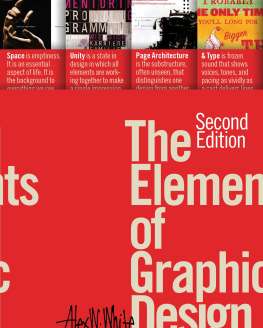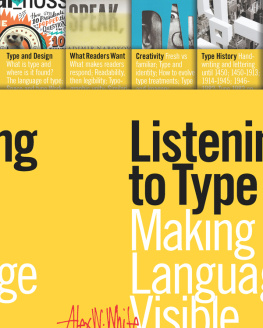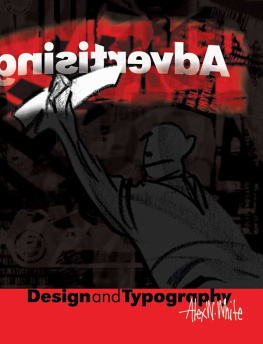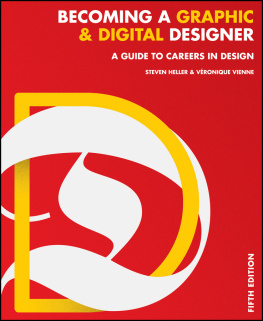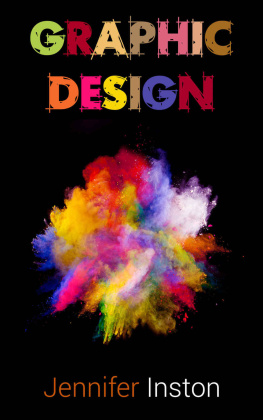Alex W. White has shaped the design of many magazines and identity programs. He has been a consultant to dozens of publications and has lectured widely on typography and design to professionals in the Americas and Europe. White recently completed ten years of service on the Board of Directors of the Type Directors Club in New York, retiring as Chairman. He has taught design for thirty years at all levels of undergraduate and graduate education at programs that include Parsons the New School for Design, FIT, The Hartford Art School, the State University of New York, City College of New York, and Manhattanville College. He is the award-winning author of Advertising Design and Typography , Thinking in Type: The Practical Philosophy of Typography , Type in Use , and Really Good Logos Explained with Margo Chase, Rian Hughes, and Ron Miriello. White lives in Westport CT.
Bibliography
The important thing about a bibliography is to use these road signs that point to further knowledge on a subject. Discovering books that help you understand and see design and visual communication in a new way is well worth the effort.
You may note that the majority of these books are released by the same few publishers. Visiting these publishers Web sites will lead you to many other worthwhile texts. A recommended reading list is also maintained at tdc.org .
Some of these books are out of print. Of these, a few are being made available again every year. Others can be found at online auction sites.
The Type Directors Club Annual. New York: Harper-Collins Publishers, published annually.
Bringhurst, Robert. The Elements of Typographic Style. Point Roberts, Wash.: Hartley & Marks, 2004. 3rd ed.
Burns, Aaron. Typography. New York: Reinhold Publishing Corp., 1961.
Carter, Harry. A View of Early Typography Up to About 1600. Oxford: Hyphen Press, facsimile reprint 2002.
Elam, Kimberly. Grid Systems: Principles of Organizing Type. New York: Princeton Architectural Press, 2005.
Fertel, Dominique. La Science Practique de lIm-primerie. 1723. Reprint: Farnborough, England: Gregg International, 1971.
Friedl, Friedrich, N. Ott and B. Stein. Typography: An Encyclopedic Survey. New York: Black Dog & Leventhal Publishers, 1998.
Frutiger, Adrian. Type Sign Symbol. New York: Hastings House, 1999.
Gill, Eric. An Essay on Typography. Boston: David R. Godine, 1993.
Ginger, E.M., S. Rgener, A-J. Pool, and Goudy, Frederic. The Alphabet and Elements of Lettering. Berkeley & Los Angeles: The University of California Press, 1942.
Heller, Steven, and Philip B. Meggs, eds. Texts on Type: Critical Writings on Typography. New York: Allworth Press, 2001.
Hutchinson, James. Letters. New York: Van Nostrand Reinhold Company, 1983.
Kunz, Willi. Typography: Macro- and Microsthetics. Sulgen, Switzerland: Verlag Niggli, 2004.
Leborg, Christian. Visual Grammar. New York: Princeton Architectural Press, 2006.
Loewy, Raymond. Industrial Design. Woodstock, N.Y. : The Overlook Press, 2007.
Lupton, Ellen and Jennifer Cole Phillips. Graphic Design: The New Basics. New York: Princeton Architectural Press, 2008.
Morison, Stanley. First Principles of Typography. Leiden, Netherlands: Academic Press Leiden, 1996. 2nd Ed.
Morison, Stanley, and Kenneth Day. The Typographic Book 1450 1935; A Study of Fine Typography Through Five Centuries. Chicago : The University of Chicago Press, 1963.
Norton, Robert. Types Best Remembered, Types Best Forgotten. Kirkland, Wash.: Parsimony Press, 1993.
Ogg, Oscar. Three Classics of Italian Calligraphy: Arrighi, Tagliente, Palatino. New York: Dover Publications, 1953.
Rand, Paul. A Designers Art. New Haven: Yale University Press, 2000.
Reas, Casey, Ben Fry, and John Maeda. Processing: A Programming Handbook for Visual Designers and Artists. Cambridge, MA: MIT Press, 2007.
Remington, R. Roger, and Barbara J. Hodik. Nine Pioneers in American Graphic Design. Cambridge, Mass.: MIT Press, 1992.
Rondthaler, Edward. Life with LettersAs They Turned Photogenic. New York: Visual Communication Books, Hastings House Publishers, 1981.
Ruder, Emil. Typographie: A Manual of Design. Adapted by Charles Bigelow. New York: Hastings House, 2002.
Sagmeister, Stefan. Made You Look. London : Booth-Clibborn Editions, 2001.
Skolos, Nancy and Thomas Wedell. Type, Image, Message: A Graphhic Design Layout Workshop. Gloucester, MA: Rockport Publishers, 2006.
Spencer, Herbert. Pioneers of Modern Typography. Cambridge, Massachusetts: MIT Press, 2004. Revised ed.
Spiekermann, Erik. Rhyme & Reason: A Typographic Novel. Berlin: H. Berthold AG, 1987.
Thompson, Bradbury. The Art of Graphic Design. New Haven: Yale University Press, 1988.
Tufte, Edward R. Beautiful Evidence. Cheshire, CT: Graphics Press, 2006.
White, Alex W. Advertising Design and Typography. New York: Allworth Press, 2007.
Woolman, Matt, and Jeff Bellantoni. Moving Type: Designing for Time and Space. Mies, Switzerland: RotoVision, 2000.
Designers checklist
Questions that should be answered with a yes are in bold. Questions that should be answered with a no are in regular weight.
| Space | Unity |
|---|
| Do all areas of white space look like they were planned and thoughtfully used? | Are all elements cooperating to make a single impression? |
| Are contrasts clear enough to look purposeful? |
| Is the ground as interesting as the figures on it? | Is there a dominant element that will transfix the casual browser? |
| Is space between elements strictly controlled and consistent? | Are elements sized in proportion to their importance? |
| Is space used to signal quality and value? | Has design unity been enhanced by limiting type and color palettes? |
| Is there a payoff for having this emptiness? |
| Does empty space define an objects relative size? | Does color emphasize what is worthy of emphasis? |
| Are related topics close and unrelated ones separated? | Is color used to explain content rather than decorate the page? |
| Can the background be brought into the foreground? |

